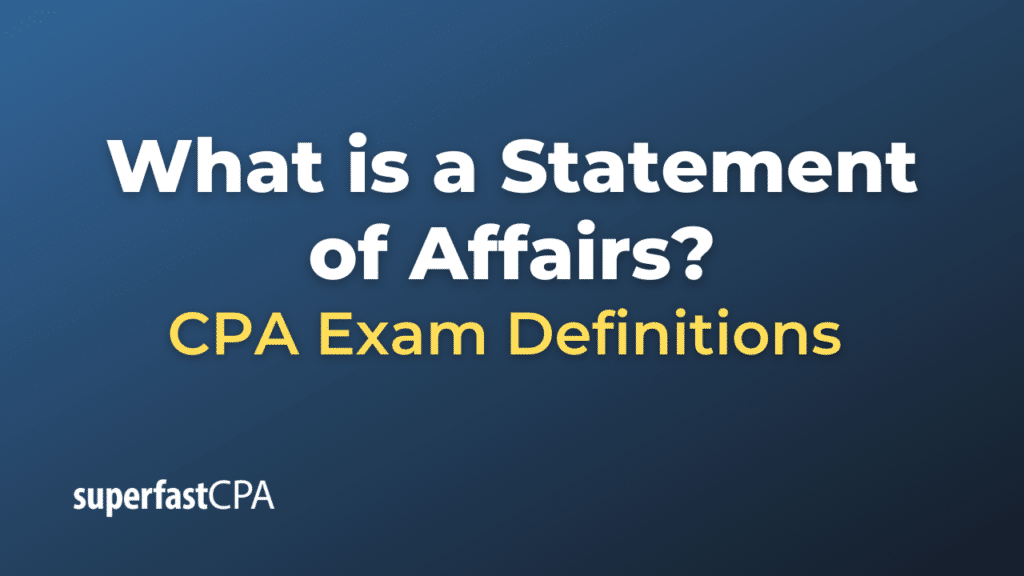Statement of Affairs
A Statement of Affairs is a financial document typically prepared when a company is facing insolvency or bankruptcy. Unlike regular financial statements, which present the financial position of a company under normal operating conditions, the Statement of Affairs is designed to give a snapshot of the company’s financial situation at a particular point in time, especially concerning its assets and liabilities.
The primary purpose of this statement is to provide creditors, administrators, and other stakeholders with a clear understanding of the company’s financial position so that informed decisions can be made about the distribution of any remaining assets.
Key elements of a Statement of Affairs include:
- Assets: These are broken down into:
- Realizable Assets: The assets that can be sold or realized to generate funds. The estimated realization values might be lower than the book values, considering the urgent or distressed nature of sales in insolvency situations.
- Book Value: The value of assets as they appear in the company’s balance sheet.
- Estimated Realizable Value: The estimated amount expected to be received from the sale of the assets.
- External Liabilities: The amounts owed to external parties, which may include:
- Secured creditors (those who have a charge over a specific asset, like a mortgage provider).
- Preferential creditors (e.g., employees owed wages).
- Unsecured creditors (e.g., suppliers, utilities).
- Deficiency/Surplus: This represents the shortfall or excess between the company’s assets and liabilities. It indicates the amount by which the company is insolvent or the surplus it might have after settling all its obligations.
- Contingent Liabilities: These are potential liabilities that arise from past events and may become actual liabilities depending on the outcome of future events. For instance, pending lawsuits where the company might need to pay damages if it loses.
- Contingent Assets: Potential assets that will only come into existence based on the outcome of future events, such as a pending lawsuit where the company might receive damages if it wins.
Example of a Statement of Affairs
Let’s further explore the Statement of Affairs for a hypothetical company, “BlueSky Innovations,” which is facing insolvency. This example will expand on the structure and provide a clearer representation of the statement:
BlueSky Innovations
Statement of Affairs
As of December 31, 2023
Assets:
| Description | Book Value | Estimated Realizable Value |
|---|---|---|
| Property (Headquarters) | $1,000,000 | $700,000 |
| Company Vehicles | $150,000 | $80,000 |
| Inventory | $300,000 | $180,000 |
| Accounts Receivable | $200,000 | $120,000 |
| Cash at Bank | $50,000 | $50,000 |
| Total Assets | $1,700,000 | $1,130,000 |
Liabilities:
| Description | Amount Owed |
|---|---|
| Secured Loan (Bank Loan against Property) | $600,000 |
| Employee Wages Due | $100,000 |
| Supplier Invoices (Unsecured) | $500,000 |
| Utilities Due (Unsecured) | $40,000 |
| Total Liabilities | $1,240,000 |
Estimated Deficiency: $110,000
( Calculated as Total Liabilities of $1,240,000 minus Estimated Realizable Value of assets of $1,130,000)
Contingent Liabilities:
Pending lawsuit which, if lost, may result in a liability of up to $80,000.
Contingent Assets:
Receivable from a client dispute, if resolved favorably, of up to $40,000.
From this Statement of Affairs for BlueSky Innovations:
- It’s evident that while the company’s book value of assets is $1,700,000, in a liquidation scenario, they expect to realize only $1,130,000.
- The total liabilities stand at $1,240,000, which exceeds the estimated realizable value of assets by $110,000. This means there’s an expected deficiency of $110,000, indicating a potential loss for unsecured creditors.
- The company also has contingent liabilities and assets, which could further impact the final amounts realized and owed.
Stakeholders, especially creditors, can use this information to determine the potential recovery or loss they might face, and make decisions accordingly.













